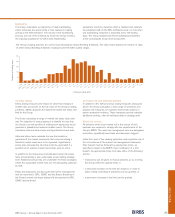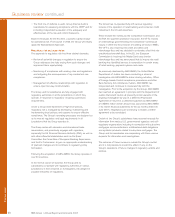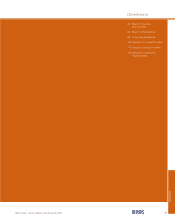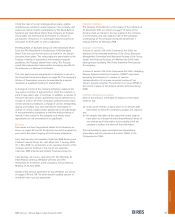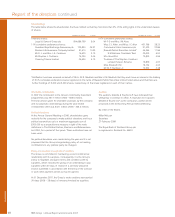RBS 2007 Annual Report Download - page 91
Download and view the complete annual report
Please find page 91 of the 2007 RBS annual report below. You can navigate through the pages in the report by either clicking on the pages listed below, or by using the keyword search tool below to find specific information within the annual report.
Business review
89
RBS Group • Annual Report and Accounts 2007
(in relation to the premium reserves). The Group holds
undiscounted claims reserves (including reserves to cover
claims which have been incurred but not reported (IBNR
reserves)) for all classes at a sufficient level to meet all
liabilities as they fall due, having regard to actuarial estimates
and the volatility observed and expected in the claims in each
class. Group policy ensures that the net unearned premium
reserves are adequate to meet the expected cost of claims
and associated expenses in relation to the exposure after the
balance sheet date. To the extent that the unearned premium
reserves, net of reinsurance and deferred acquisition costs are
inadequate, a liability adequacy provision will be held.
The Group’s policy is to hold appropriate levels of provisions,
typically in excess of the actuarial best estimate, for the major
classes of business.
Frequency and severity of specific risks and sources
of uncertainty
The Group’s focus in its insurance operation is on high volume
and relatively straightforward products, for example home and
motor. This facilitates the generation of comprehensive
underwriting and claims data, which are used to accurately
price and monitor the risks accepted. This attention to data
analysis is reinforced by tight controls on costs and claims
handling procedures.
Most general insurance contracts are written on an annual
basis, which means that the Group’s liability extends for a
twelve month period, after which the Group is entitled to
decline or renew or can impose renewal terms by amending
the premium, terms and/or conditions.
Uncertainty regarding possible frequency and severity of
claims arise as follows:
a) Motor insurance contracts (private and commercial): claims
experience varies, but the principal factors include age,
gender and driving experience, together with the type of
vehicle and location.
b) Property insurance contracts (residential and commercial):
short-term uncertainty is mainly driven by weather conditions.
Over a longer period, the strength of the economy is also a
factor.
c) Other commercial insurance contracts: claims may arise
from business interruption and loss arising from the negligence
of the insured (liability insurance). Business interruption losses
come from the loss of income, revenue and/or profit as a result
of property damage claims. Liability insurance includes
employers liability and public/products liability.
Fluctuations in the social, economic and legislative climate are
a source of uncertainty in the Group’s general liability account,
and in particular court judgements and legislation, significant
events (for example terrorist attacks), any emerging new heads
of damage and types of claim that are not envisaged when the
policy is written.
Life business
The three regulated life companies of the Group, National
Westminster Life Assurance Limited, Royal Scottish Assurance
plc and Direct Line Life Insurance Company Limited, are
required to meet minimum capital requirements at all times
under the Financial Service Authority’s Prudential Sourcebook.
The capital resources covering the regulatory requirement are
not transferable to other areas of the Group. To ensure that the
capital requirement is satisfied at all times, each company
holds a voluntary buffer above the regulatory minimum.
The Group is not exposed to price, currency, credit, or interest
risk on unit linked life contracts but it is exposed to variation in
management fees. A decrease of 10% in the value of the
assets would reduce the asset management fees by £2 million
per annum (2006 – £5 million). The Group also writes
insurance contracts with minimum guaranteed death benefits
that expose it to the risk that declines in the value of underlying
investments may increase the Group’s net exposure to death risk.
Operational risk
Operational risks are inherent in the Group’s business.
Operational risk losses occur as the result of fraud, human
error, missing or inadequately designed processes, failed
systems, damage to physical assets, improper behaviour or
from external events.
To ensure appropriate responsibility is allocated for the
management, reporting and escalation of operational risk, the
Group operates a three lines of defence model which outlines
principles for the roles, responsibilities and accountabilities for
operational risk management:
•The first line of defence is the business line management.
This is where the primary responsibility resides for the
identification, management and mitigation of the risks
associated with the products and processes of the business.
This accountability includes regular testing and certification
of the adequacy and effectiveness of controls and
compliance with Group Policies including the Group’s
Operational Risk Policy and Principles (“ORPP”).
•The second line of defence is the Operational Risk
community. The Group Operational Risk department is
responsible for the design and ownership of the ORPP. The
ORPP provides the principles and minimum standards for
delivering effective operational risk management. It
incorporates key processes including risk and control
assessment, scenario analysis, loss data collection, new
product approval process, key risk indicators, notifiable
events process, and the self certification process.
Implementation of the ORPP is facilitated and overseen by
Divisional Operational Risk teams who provide expert
support and advice as well as oversight and challenge to
business line management.








